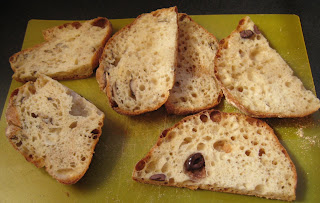This dish is adapted from a recipe appearing on page 45 of the November/December
Vegetarian Times. The published recipe is "Barley Risotto with Spinach and Tofu." In that issue there are several risotto recipes that do not call for
Arborio rice, which is what is normally used for risotto. This recipe calls for quick-cooking barley, but I didn't have enough on hand to make the complete recipe, so I used a mixture of barley and rice. Also, since I had on hand some beautiful organic mixed greens from my
CSA veggie basket, I substituted them for the spinach. So I steamed the greens separately before adding them to the dish. And I omitted the tofu.
I found that it took much much longer to cook than the recipe says, and that I needed much more hot broth/liquid than the recipe called for as well. But perhaps if I had used the stated amount of barley instead of a combination of rice and barley, it may have cooked more in line with the recipe. In any event, the flavors are delicious, so it is worth sharing.
Barley Risotto with Spinach and Tofu, adapted from Vegetarian Times
Serves 6
six cups of vegetable broth (or more, as needed)
2 cups quick-cooking barley
2 tablespoons olive oil, divided
3 large shallots, chopped or one cup chopped red onion
2 cloves garlic, chopped
2/3 cup dry white wine or sherry cooking wine
1/2 cup sun dried tomatoes, chopped (and drained if oil packed)
12 oz fresh baby spinach or if substituting fresh greens: steam, squeeze out excess water, then chop
1 8 oz package baked garlic-herb tofu, cubed (optional)
3 tablespoons grated Parmesan cheese (plus more for garnish, if desired)
3 tablespoons chopped fresh chives or 1 tablespoon chopped fresh sage
1. Put the broth in a pot to boil, then keep simmering on the back burner.
2. In a medium-hot dry skillet, toast the barley, stirring often, about five minutes. Set aside.
3. In a heavy pot, heat one tablespoon of the oil and saute the shallots or onion for about 4 minutes, stirring often. Add the garlic and the toasted barley and stir about 2 minutes. Add the wine and simmer for about 3 minutes or until the liquid is almost all absorbed.
4. Add 1/2 cup of the hot broth and the sun-dried tomatoes and simmer about 4 more minutes or until liquid is mostly absorbed, stirring constantly. Add fresh spinach a few handfuls at a time and cook until wilted. Continue adding the hot broth about 1/2 cup at a time, stirring until mostly absorbed and then keep repeating: add broth, stirring until liquid is mostly absorbed, then adding more broth... If using steamed greens instead of fresh spinach, stir them in bit by bit.
5. When the barley is just about tender, add the cubes of tofu (if using) and chives or sage and heat through and let the flavors blend. Then, stir in the shredded cheese and remaining tablespoon of olive oil.





 These tamales are made using banana plant leaves, rather than corn husks. The banana leaves impart a flavor to the dough as it cooks. The dough is spread on the banana leaf and is topped with chopped boiled eggs, ground
These tamales are made using banana plant leaves, rather than corn husks. The banana leaves impart a flavor to the dough as it cooks. The dough is spread on the banana leaf and is topped with chopped boiled eggs, ground 










